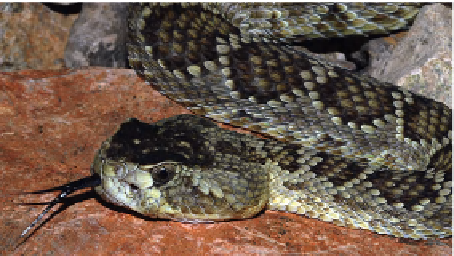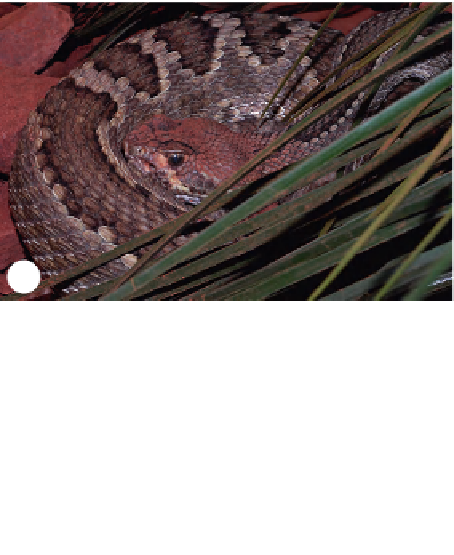Biology Reference
In-Depth Information
Plate 4.88
(
Continued)
venoms that contain the monomeric presynaptic neurotoxin,
ammodytoxin B, and/or the heterodimeric postsynaptic neurotoxin, vaspin. Deaths have
occurred, but are rare. Although it is reasonable to consider the possibility that some of
the few medically significant bites by Montpellier snakes (
Malpolon monspessulanus
) that
included cranial nerve palsies were cases of misidentified
V. aspis
, this is unlikely as these
snakes differ markedly in appearance.
(A-C)
Vipera aspis
, South France.
(
Plate 4.88
A, male; B, female).
(D)
Vipera aspis
, Tuscany.
Plate 4.88
A-C, photos copyright to Dave Nixon;
Plate 4.88
D,
photo copyright to Wolfgang Wüster.
(A)
(B)
Plate 4.89
(A and B) Mojave rattlesnake (
Crotalus scutulatus
).
Probably the most
dangerous venomous snake of North America,
C. scutulatus
has highly variable venom that
may contain the potent presynaptic dimeric neurotoxin, Mojave toxin. This crotaline species
ranges from the southwestern USA through Mexico. The populations that produce venom
containing Mojave toxin have been termed “Type A,” while those without this toxin have
been called “Type B.” There are populations that appear to be intergrades of Types A and
B.
Crotalus scutulatus
envenomations may present as those “typical” of most
Crotalus
spp.
(moderate-to-severe local effects, coagulopathy, hypotension, myolysis, etc.), and/or with
severe paralytic features. Tragically, the well-known American physician-herpetologist,
Frederick Shannon (1921-1965), was fatally envenomated while working with a wild
C. scutulatus
.
Photos copyright to David A. Warrell.


